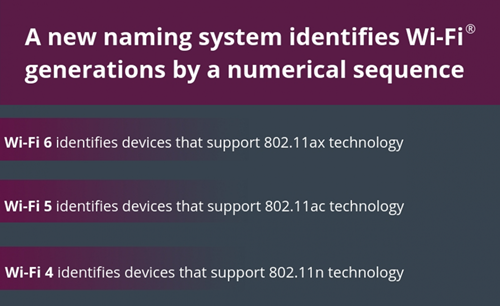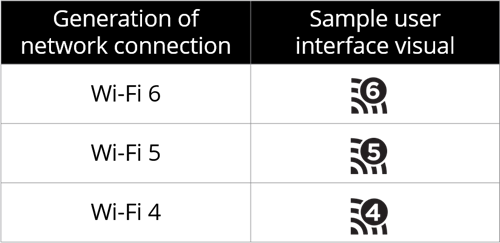WiFi 6 has become a new buzzword! Besides knowing that it is the sixth generation of WiFi behind the 802.11ax specification, we have little idea about this technology. So, what does this technology hold for us, and how is it different from its previous iterations? These are some of the questions we will attempt to answer in today’s post!
What is Wi-Fi 6

Wi-Fi 6 is a new labeling convention developed by the Wi-Fi Alliance, a non-profit organization that promotes Wi-Fi technology and certifies Wi-Fi products in compliance with certain interoperability standards. The new labeling is considered the faster version of Wi-Fi technology we have been using for more than a decade now.
The organization came up with the convention since the earlier names were difficult to recall (real name being 802.11ax). The Wi-Fi currently in use, 802.11ac, is also known as Wi-Fi 5 and supports a speed of up to 3.5 Gbps. Wi-Fi 6 will support 9.6 Gbps, more than double the 3.5 Gbps you get with Wi-Fi 5.

Let us further explore:
- Differences between Wi-Fi 4, Wi-Fi 5 and Wi-Fi 6 technology
- Why do we need Wi-Fi 6
- Key benefits of Wi-Fi 6 technology
- How Wi-Fi 6 technology will work?

1] Differences between Wi-Fi 4, Wi-Fi 5 and Wi-Fi 6 technology.
| WiFi 4 | WiFi 5 | WiFi 6 |
| identifies devices that support 802.11n technology | identifies devices that support 802.11ac technology | identifies devices that support 802.11ax technology |
| This standard support speeds up to 600Mbps | This standard supports data rates up to 3.46Gbps. | support 9.6 Gbps, (Almost double the 3.5 Gbps you get with Wi-Fi 5 |
| Operates between two frequencies – 2.4GHz and 5GHz, | Operate in the 5 GHz frequency space | While still operating in the 2.4GHz and 5GHz spectrum this standard aims to improve the performance in WLAN deployments in dense scenarios, such as sports stadiums, airports, etc. |
| WiFi 4 has a modulation of just 64-QAM | In modulation mode, WiFi is 5-256-QAM | WiFi-6 has a modulation mode of1024-QAM |
2] Why Wi-Fi 6
The ubiquity of Wi-Fi and its ability to complement other wireless technologies like Artificial Intelligence is slowly translating the vision of connecting everyone and everything into reality. At the same time, the popularity of Wi-Fi has created very diverse and densely populated Wi-Fi conditions. This calls for new technological advances to meet users’ needs. Wi-Fi 6 believes it has answers to this as it will possess the capability to enable Wi-Fi devices to operate efficiently in the most dense and dynamic connectivity settings.
Users demand stable performance in the most demanding Wi-Fi environments, in addition to robust connectivity and speed. Wi-Fi 6 promises to deliver this, alongside other benefits.
Read: What is Wi-Fi 6E?
3] Key benefits of Wi-Fi 6 technology
- High performance in environments having many devices connected.
- Increased capacity
- Higher data transfer rates
- Improved power efficiency
In addition to the above, devices certified by this technology a.k.a. Wi-Fi CERTIFIED 6 devices will meet the highest standards for security and interoperability. Besides, they’ll also enable lower battery consumption, making it a preferred choice for the Internet of Things (IoT) and emerging applications like,
- Virtual and augmented reality used in e-Learning
- Healthcare
- Telepresence
Wi-Fi 6 is considered the ideal choice for developing the Internet of Things because it supports the TWT (Target Wakeup Time) technology. The technology enables devices to determine the number of times they can send or receive data, which in turn allows 802.11ax (WiFi 6) access points to increase device sleep time and significantly conserve battery life effectively. This idea remains a core feature in the development of IoT. In addition, Target Wake Time enables wireless access points and devices to negotiate and define specific times to access the medium. This optimizes spectral efficiency by manifolds and reduces contention and overlap between users.
Read: How to tell if my PC has WiFi 6?
4] How Wi-Fi 6 technology works?
Wi-Fi 6 mainly uses two technologies – MU-MIMO and OFDMA.
- MU-MIMO stands for ‘multi-user, multiple-input, multiple-output’. It is supported by routers and endpoint devices. The technology increases the number of antennas on a wireless router that is used for both receiving and transmitting, improving the capacity for wireless connections.
- OFDMA – It stands for ‘orthogonal frequency division multiple access’ and as the name suggests, the technology allows single AP connect simultaneously to multiple clients with varying bandwidth requirements.
We are already experiencing a demand for increased capacity and throughput speeds. This will continue to grow further as users keep adding more wireless devices to each network and expect faster response times for their activities (streaming favorite videos or downloading large files). As such, moving to WiFi 6 or 802.11ax technology that promises to meet all our demands will seem like the most viable option.